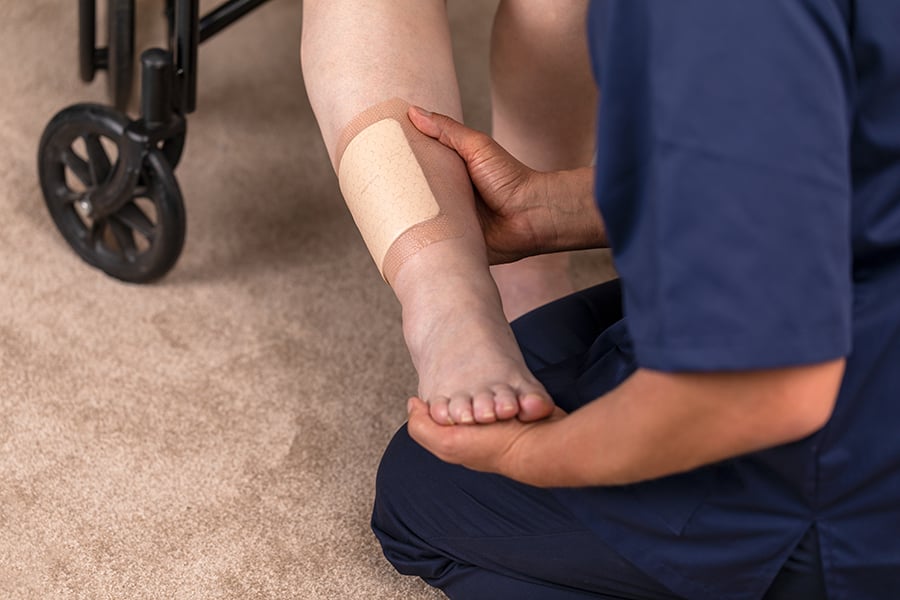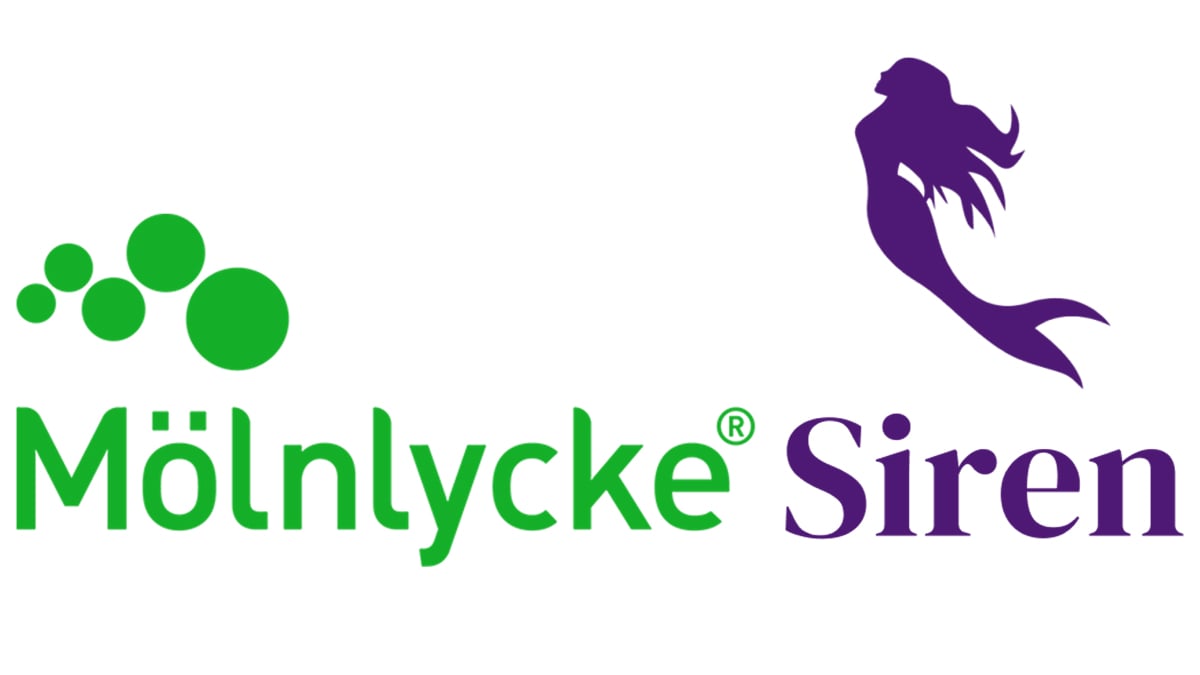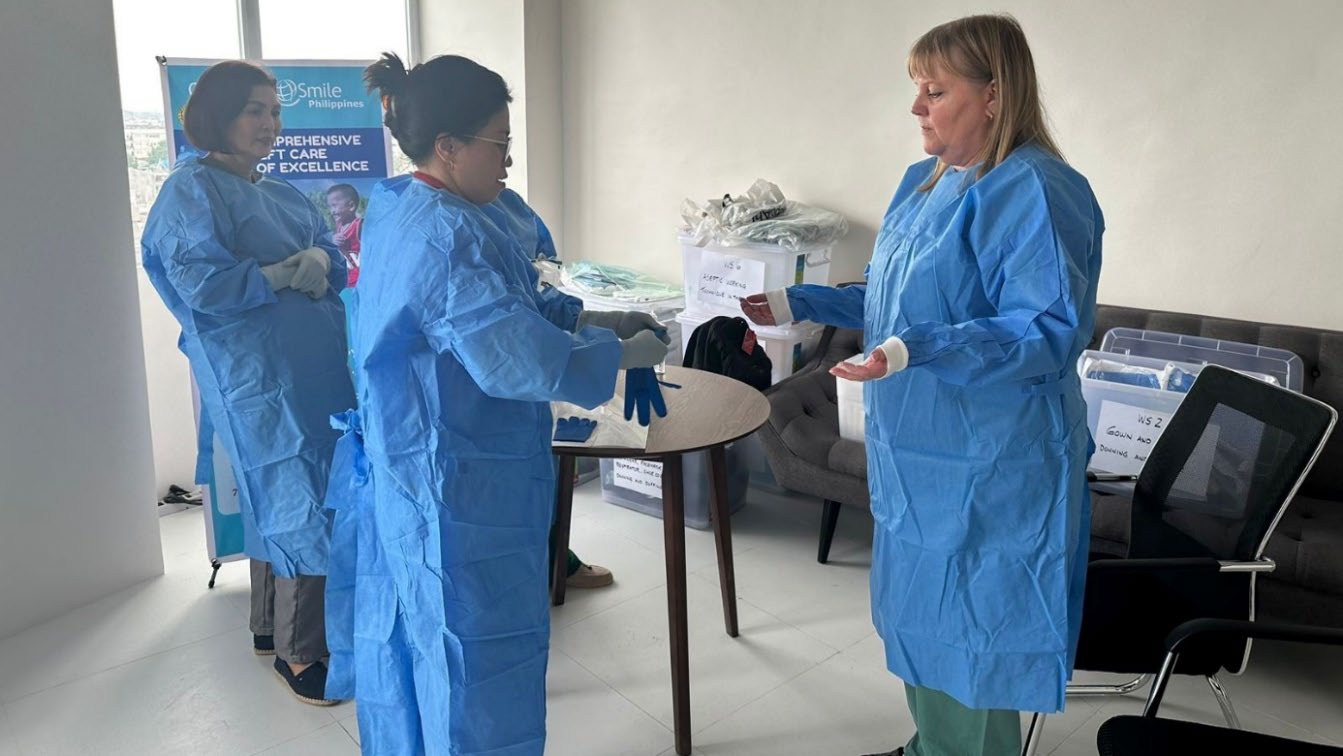Sofia Lindqvist
Media & Financial Communications Manager
Email: sofia.lindqvist@molnlycke.com
Phone: +4672 255 35 09

Barcelona, Spain. 27 March 2025. New study reports that switching patients with chronic wounds to the multi-layered, bordered silicone-coated foam dressing, Mepilex® Border Flex, alongside a clinician educational support programme, resulted in a significant reduction in the number of dressing changes being undertaken and a reduction in dressing-related costs.1
The study, sponsored by Mölnlycke Health Care, and conducted across primary care facilities in Seville, Spain was today presented as an e-poster at the 35th Conference of the European Wound Management Association (EWMA) 2025 in Barcelona, Spain by the principal investigator Dr Andres Roldan Valenzuela, Centro de Salud Mairena del Aljarafe – Cuidad Expo, Seville.
The primary outcome of the study was a statistically significant reduction in the number of dressing changes undertaken, prior to and after the switch from a bordered foam dressing (baseline) to Mepilex® Border Flex; results demonstrated the median number of dressing changes reduced during the study period, from three in a seven-day period to just one.1
Other reported outcomes included:1
Almost all (97%) of the clinicians rated the overall performance of Mepilex® Border Flex to be better than the previously used dressings, while 100% of patients rated Mepilex® Border Flex as ‘good’ to ‘very good’ in terms of overall satisfaction, compared to 65% for the previously used dressings.
Dr Andres Roldan Valenzuela, principal investigator commented “The results of this study clearly demonstrate how simple changes to a wound care treatment regime can bring about positive outcomes for both patients and healthcare providers. At a time when healthcare systems and staff are under increasing pressure on both cost and time it is encouraging that there are solutions to help drive efficiencies and improve outcomes for all involved.”
For more information, please contact:

Media & Financial Communications Manager
Email: sofia.lindqvist@molnlycke.com
Phone: +4672 255 35 09
The study involved 37 adult patients, aged between 30 and 90+ years presenting with wounds that had not reduced in size by >40-50% in the previous month and had been managed with foam dressing (other than Mepilex® Border Flex), for a minimum of four weeks (baseline). Category 2 pressure ulcers (24.3%) and venous leg ulcers (18.9%) were the most common wound types. Patients in the study had Mepilex® Border Flex applied to their wounds for ≥4 weeks, in conjunction with standard of care.

“Our strong financial position and continued growth allow us to direct our future and continued investments. At the same time, it is clear that our strategy and previous investments have paid off, enabling close relationships with our customers working alongside them to handle the challenges of healthcare today,” says Zlatko Rihter, CEO of Mölnlycke. Highlights from the year: Continued strong growth at 7.4% compared to previous year and annual sales of EUR 2,064 million with improved profitability. The progress in becoming a leader in sustainable healthcare was recognised with a platinum medal from EcoVadis. Focus on transformation through partnerships commenced in 2024 with the acquisition of P.G.F. Industry Solutions, the strategic partnership with Ondine Biomedical Inc and strategic investments in MediWound and Siren. The joint venture Tamer Mölnlycke Care in Saudi Arabia has started production and there are plans for expansion in India and China. Download and read the full report on www.molnlycke.com/corporate/about/reports For more information, please contact: [Contact card] Sofia Lindqvist

Barcelona, Spain. 27 March 2025. New study reports that switching patients with chronic wounds to the multi-layered, bordered silicone-coated foam dressing, Mepilex® Border Flex, alongside a clinician educational support programme, resulted in a significant reduction in the number of dressing changes being undertaken and a reduction in dressing-related costs.1 The study, sponsored by Mölnlycke Health Care, and conducted across primary care facilities in Seville, Spain was today presented as an e-poster at the 35th Conference of the European Wound Management Association (EWMA) 2025 in Barcelona, Spain by the principal investigator Dr Andres Roldan Valenzuela, Centro de Salud Mairena del Aljarafe – Cuidad Expo, Seville. The primary outcome of the study was a statistically significant reduction in the number of dressing changes undertaken, prior to and after the switch from a bordered foam dressing (baseline) to Mepilex® Border Flex; results demonstrated the median number of dressing changes reduced during the study period, from three in a seven-day period to just one.1 Other reported outcomes included:1 32% wounds healed by the final visit 50% reduction in wound area in four weeks in 75% of patients Two thirds (68.7%) reduction in wound area from baseline to the final visit Reduced pain at dressing changes (pain severity scores of 3.1 - 3.3 at baseline associated with previously used dressings, compared to scores of 0.5 - 1.1 recorded with Mepilex® Border Flex at the final visit) 44% reduction in weekly dressing cost per patient (5.38€ less after the dressing switch) No dressing related adverse events Almost all (97%) of the clinicians rated the overall performance of Mepilex® Border Flex to be better than the previously used dressings, while 100% of patients rated Mepilex® Border Flex as ‘good’ to ‘very good’ in terms of overall satisfaction, compared to 65% for the previously used dressings. Dr Andres Roldan Valenzuela, principal investigator commented “The results of this study clearly demonstrate how simple changes to a wound care treatment regime can bring about positive outcomes for both patients and healthcare providers. At a time when healthcare systems and staff are under increasing pressure on both cost and time it is encouraging that there are solutions to help drive efficiencies and improve outcomes for all involved.” For more information, please contact: [Contact card] Sofia Lindqvist About the study design The study involved 37 adult patients, aged between 30 and 90+ years presenting with wounds that had not reduced in size by >40-50% in the previous month and had been managed with foam dressing (other than Mepilex® Border Flex), for a minimum of four weeks (baseline). Category 2 pressure ulcers (24.3%) and venous leg ulcers (18.9%) were the most common wound types. Patients in the study had Mepilex® Border Flex applied to their wounds for ≥4 weeks, in conjunction with standard of care.

“At Mölnlycke, we believe that education is a cornerstone of progress in healthcare. The 2025 Future Summit exemplifies our commitment to fostering innovation, enhancing clinical practice, and building partnerships that enable healthcare professionals to improve patient outcomes”, says Emma Wright, Chief Medical Officer at Mölnlycke Health Care. “We are thrilled to bring together such a diverse and accomplished group of experts to shape the future of wound care.” Offering a unique platform for collaboration Set to be a highlight of the professional education calendar, the 2025 Future Summit will host over 130 HCPs from vascular, orthopedic, general, and plastic surgery specialties. With the participation of global faculty leaders, the event will provide a unique platform to explore cutting-edge advancements, share best practices, and foster interdisciplinary collaboration in wound care and surgical excellence. The summit will take place on October 6-7, 2025, in the Netherlands and will be presided over by renowned experts Professor Javad Parvizi and Mr. Ibby Younis. “The Future Summit reflects the power of partnership and education in driving medical advancements,” says Professor Javad Parvizi, co-president of the summit. “By bringing together experts from diverse specialties, this event creates a unique opportunity to exchange knowledge and redefine standards in wound care and surgery.” A catalyst for innovation Attendees of the summit will be provided with the opportunity to engage in meaningful dialogue, access the latest clinical insights, and participate in interactive workshops led by global faculty leaders. “This summit is not just an event; it is a catalyst for innovation. It empowers clinicians from across EMEA to collaborate, learn, and apply transformative approaches that will ultimately improve patient care. Mölnlycke’s unwavering commitment to education is truly commendable,” says Mr. Ibby Younis, co-president of the summit. For more information, please contact: Sofia Lindqvist Media Relations Manager Email: sofia.lindqvist@molnlycke.com Phone: +46 72 255 35 09

Gothenburg, Sweden. 28 January 2025. “This is a significant milestone in Mölnlycke’s commitment to halving Scope 1 and 2 greenhouse gas emissions by 2030” said Caterina Camerani, VP Sustainability at Mölnlycke. “It propels us towards our vision of building a sustainable healthcare manufacturing ecosystem.” A major enabler in reaching the goal was signing two virtual Power Purchase Agreements (vPPAs) for the regions where the company has the highest manufacturing footprint. To cover electricity consumption for the sites in the European Union, Mölnlycke signed a long-term vPPA committing to purchasing renewable electricity generated in Mutkalampi, the largest wind farm in Finland. The three manufacturing plants in Malaysia will handle their renewable electricity needs through a similar vPPA from a newly established solar power plant in Bukit Kayu Hitam, Malaysia. In addition, Mölnlycke continues to invest in on-site generation of solar energy with manufacturing sites in Malaysia and the UK having completed the installation of rooftop solar panels and the installation on factories in Thailand ongoing. The remaining electricity consumption needs for the established manufacturing sites in Thailand, the UK and the US, as well as the newly established plant in the Kingdom of Saudi Arabia are met through Renewable Energy Certificates (RECs). As stated in the near-term goal validated by SBTi, Mölnlycke will continue active sourcing of renewable electricity through 2030. For more information, please contact: [Contact card] Sofia Lindqvist

Gothenburg, Sweden. 8 January 2025. Mölnlycke Health Care, a world-leading MedTech company specialising in wound care solutions, announced today an investment of USD 8 million in Siren. The healthcare tech company Siren is on a mission to help reduce the risk of diabetic foot ulcers by early detection of potential injuries through temperature-sensing textile technology. About 830 million people around the world suffer from diabetes1, living with the risk of diabetic foot ulcers (DFU) and amputation. Siren has developed “the Siren sock” as well as remote patient monitoring clinical teams, creating a service ecosystem for patients at risk of DFU. The system has been clinically proven to reduce the risk of ulcers by up to 68%2 and amputations by 83%2. This means less suffering for patients and is estimated to lower the cost of care by approximately USD 10,000 per patient annually. In addition, the workload for physicians is reduced, which is increasingly important in the pressurised healthcare environment. “Our strategic investment in Siren reflects our commitment to integrating into digital ecosystems and pioneering innovative digital solutions that revolutionise healthcare delivery,” says Zlatko Rihter, CEO of Mölnlycke and continues “Helping to prevent wounds from occurring is also in line with Mölnlycke’s Wound Care mission to ‘help free patients from the burden of wounds’ and our ambition to further support healthcare in the post-acute segment.” “We’re excited to team up with Mölnlycke to tackle diabetic foot ulcers at their earliest stages”, says Ran Ma, co-founder and CEO of Siren. “By investing in preventive technologies like ours, Mölnlycke is demonstrating real vision and leadership in helping patients avoid the debilitating consequences of diabetic foot ulcers. Their investment sends a clear message that prevention matters. By catching issues before they escalate, we can help patients stay healthy and independent, reduce unnecessary procedures, and ultimately make a real difference in their lives.” This investment marks a significant step forward in the fight against diabetic foot ulcers, combining Mölnlycke’s expertise in wound care with Siren’s innovative technology. Together, the aim is to enhance patient outcomes, reduce healthcare costs and alleviate the burden on healthcare providers. For more information, please contact: [Contact card] Sofia Lindqvist About Siren Siren is at the forefront of smart wound care technology, specialising in innovative solutions that revolutionise the way diabetic foot ulcers and other wound types are prevented and managed. Through its unique blend of technology, clinical evidence, and patient-centered design, Siren is dedicated to enhancing quality of life and reducing healthcare costs for patients worldwide. www.siren.care About Siren’s solution Siren has developed a technology for integrating sensors into a yarn that can be converted into textiles. The technology has been incorporated into temperature-sensing socks for monitoring diabetic patients for early signs of DFU by detecting hot-spots on the feet. The socks are fitted with Bluetooth connectivity, battery and an accelerometer tracking patient movement. Besides the physical socks, Siren has also established a remote patient monitoring team of home-based wound care nurses. The sock continuously tracks patients and sends alerts to the remote care team on any signs of hot spots development and allows for an early triaging and intervention, enabling the Siren to minimize false positives and reduce physician workload. References WHO, https://www.who.int/health-topics/diabetes Shih et al., Effectiveness of a Continuous Remote Temperature Monitoring Program to Reduce Foot Ulcers and Amputations: Multicenter Postmarket Registry Study, JMIR Diabetes 2024

Gothenburg, Sweden. 26 November 2024. The award ceremony was held on 25 November at the Nobel Prize Museum in Stockholm, Sweden where Susanne Larsson, CFO & EVP IT, Digital Enablement, GBS and Indirect Procurement and Caterina Camerani, VP Sustainability at Mölnlycke, accepted the award on behalf of the company. “Our ambition is to transform our business to become a global leader in sustainable healthcare. This award is proof that we are on the right track. We are dedicated to equipping our customers with innovative and sustainable healthcare solutions – for our customers, our employees, our communities and the planet,” says Caterina Camerani, VP Sustainability at Mölnlycke. Mölnlycke ProcedurePak® trays enhance efficiency¹ and help decarbonise healthcare by reducing waste and greenhouse gas (GHG) emissions². ProcedurePak® offers a sterile tray with all necessary components, reducing setup time in the Operating Room by up to 40%¹, and packaging waste by up to 90%² compared to procedures conducted with single-packed products. In one tray package, hospitals can simplify procurement and help ensure patient safety³. The streamlined workflow decreases manual tasks, alleviating stress and freeing up more time for healthcare professionals to focus on patient care. Digital tools like the Mölnlycke Portal and CO2 calculator together with ProcedurePak® Value Report allow hospitals to quantify reductions in waste and GHG emissions, aligning with both sustainability and operational objectives. The judging panel commented: “In recognition of outstanding contributions to sustainability and innovation, this year’s Swedish award celebrates a project that has significantly enhanced operational efficiency while reducing environmental impact. Their commitment to sustainability is further demonstrated by reducing waste, CO2 emissions and preparation time while ensuring patient safety.” For more information, please contact: [Contact card] Sofia Lindqvist About the Cagemini Nordic Sustainability Tech Award The Capgemini Nordic Sustainability Tech Award celebrates organisations across the Nordic region creating innovative technology solutions for a sustainable future. The urgency of the global climate crisis demands ground-breaking technology and IT service innovations that scale across industries. The Nordic Sustainability Tech Award celebrates the inspirational tech pioneers pushing the boundaries of sustainable IT and their role in limiting the environmental and social impact of climate change. References 1 Greiling. A multinational case study to evaluate and quantify time-saving by using custom procedure trays for operation room efficiency. (poster from 2010). 2 Assessing the carbon and waste benefits of moving to Procedure Packs at Royal Liverpool and Broadgreen University Hospitals, NHS Trust, 2011. 3 Optimisation of perioperative procedural factors to reduce the risk of surgical site infection in patients undergoing surgery: a systematic review Key findings P. Calò , F. Catena, D. Corsaro, L. Costantini, F. Falez, B. Moretti, V. Parrinello, E. Romanini, A. Spinarelli, G. Vaccaro, F. Venneri. Discov Health Systems 2, 6 (2023). https://doi.org/10.1007/s44250-023-00019-9.

Gothenburg, Sweden. 25 November 2024. Guillaume Joucla has been appointed new Chief Financial Officer (CFO) at Mölnlycke Health Care. Guillaume Joucla will take office as CFO and member of Mölnlycke’s Executive Leadership Team, as of 1 January 2025. Guillaume Joucla most recently comes from the role of VP Global Finance & Strategic Projects Operating Room Solutions at Mölnlycke. He has also led global cross-functional transformational programmes and held General Manager positions of local operations. Guillaume Joucla wealth of experience from his extensive career within Mölnlycke has equipped him with deep insights into the company’s operations and strategic direction. “We are thrilled to welcome Guillaume to our executive team,” said Zlatko Rihter, CEO of Mölnlycke. “His leadership and expertise will be instrumental in driving our financial strategy and supporting our growth initiatives going forward.” Guillaume Joucla has a distinguished career; before joining Mölnlycke in 2008 he held senior management roles at ProxiMed Services and BioSteril. He holds a Postgraduate degree in Finance & Management from IAE Aix-Marseille Graduate School of Management, and a Master's degree in applied mathematics from Aix-Marseille University. “I am excited to continue my journey at Mölnlycke Health Care and contribute to our ongoing success,” said Guillaume Joucla. “I look forward to working with the talented team to build on Mölnlycke’s strong foundation and contribute to our future as we revolutionise care for people and planet.” Guillaume will assume the new position as of 1 January 2025 and will be taking over from Susanne Larsson, who is leaving Mölnlycke to pursue an opportunity outside of the organisation. -Ends- For more information, please contact: [Contact card] Sofia Lindqvist

Gothenburg, Sweden. 19 November 2024. The Cebu Comprehensive Cleft Care Center of Excellence is now officially inaugurated. This milestone is a result of the longstanding partnership between Mölnlycke and Operation Smile – a global non-profit charity organisation. The centre will bring comprehensive care to people born with a cleft lip or palette (CLP) in the region and is expected to serve 10,000 patients in the first three years of its operations. The incidence of babies born with cleft lip and cleft palate is higher in South-East Asia than in other regions globally. The new clinic will offer life-changing surgeries and comprehensive cleft care to patients in the region where access to healthcare services is difficult. “The support from Mölnlycke in establishing the centre is grounded in our commitment to ensure equitable access to healthcare for all and the vision we have for achieving sustainable healthcare. A part of this vision is making the centre self-sufficient, and that includes raising the level of knowledge of the local healthcare professionals in the areas where Mölnlycke can offer expertise”, comments Eric de Kesel, COO & EVP Sustainability, Mölnlycke. “Cleft patients continue to be stigmatised and we are delighted to be able to contribute to changing their lives and fully including them in society,” he adds. “This clinic is a milestone for us, but also for cleft care globally, as it is also a training hub. In a rather lengthy construction project, our partner Mölnlycke has supported us financially while, in parallel with the construction, we have jointly created and rolled out a training programme with innovative methods and solutions,” says Emiliano Romano, Executive Director, Operation Smile Philippines. “Together with some of our volunteers, clinical specialists from Mölnlycke are training the local healthcare professionals in areas such as infection prevention.” The Cebu Comprehensive Cleft Care Center of Excellence is located at the Cebu City Medical Center (CCMC) hospital, in the Philippines. It is a 2,000 m2 state-of-the-art facility providing an optimal environment for delivering comprehensive CLP services, including speech therapy, dental and psychosocial care - in addition to the areas supporting the surgical flow, in alignment with the vision of surgical care that Mölnlycke and Operation Smile share. It is also fully manned by the local healthcare workers. -Ends- For more information, please contact: [Contact card] Sofia Lindqvist About Operation Smile Operation Smile is a leading global nonprofit bridging the gap in access to essential surgeries and health care, starting with cleft surgery and comprehensive care. We provide medical expertise, training, mentorship, research and care through our dedicated staff and volunteers around the world, working alongside local governments, nonprofits, and health systems, and supported by our generous donors and corporate partners. Visit Operation Smile for more information.

Today, Mölnlycke Health Care, a world leading MedTech company, specialising in wound care and wound management announce a research collaboration with Transdiagen (TDG), a precision medicine company developing drugs and diagnostics for chronic wound healing and tissue regeneration. The collaboration aims to use TDG’s novel wound gene signatures to further explore Mölnlycke products. Emma Wright, EVP Chief Medical Officer, Mölnlycke commented, “We are excited by our research collaboration with TDG allowing us to be at the forefront of advanced understanding of chronic wounds. This opens up a wealth of opportunities for future innovation in the under resourced and under prioritised area of wound care.” James Harding, CEO, Transdiagen added “We are thrilled to be working with Mölnlycke on this R&D programme. This collaboration will allow Mölnlycke access to TDG’s novel models to generate functional insights regarding the mode of action of innovative and biological wound treatment solutions. We believe this marks a new chapter in the approach to data driven, evidence-based product development for the treatment of complex wounds.” The collaboration will be initiated shortly. For more information, please contact: Jennifer Doak contact card About Mölnlycke Mölnlycke Health Care is a world-leading MedTech company that specialises in innovative solutions for wound care and surgical procedures. Mölnlycke products and solutions are used daily by hospitals, health care providers and patients in over 100 countries around the world. Founded in 1849, Mölnlycke is owned by Investor AB and headquartered in Sweden. www.molnlycke.com About Transdiagen Transdiagen (TDG) is a precision medicine company developing drugs and diagnostics for chronic wound healing and tissue regeneration. TDG is driven by the molecular understanding and clinical outcome of chronic wounds and to delivering the right treatment, to the right patient, at the right time. TDG has developed novel Ex Vivo models built on clinically validated mRNA biomarkers linking clinical data and patient outcomes. This is the most advanced disease understanding platform for chronic wounds, and powers the creation of novel diagnostics and drugs. The TDG development models and molecular insights translate laboratory data to clinical outcomes, transforming the development lifecycle of novel interventions directing efficacy, product development, disease, and patient selection. TDG is headquartered in the UK. www.transdiagen.com
Get knowledge, learn about our products, get support and more.
Find jobs, our financial reports and more.
Mölnlycke corporate